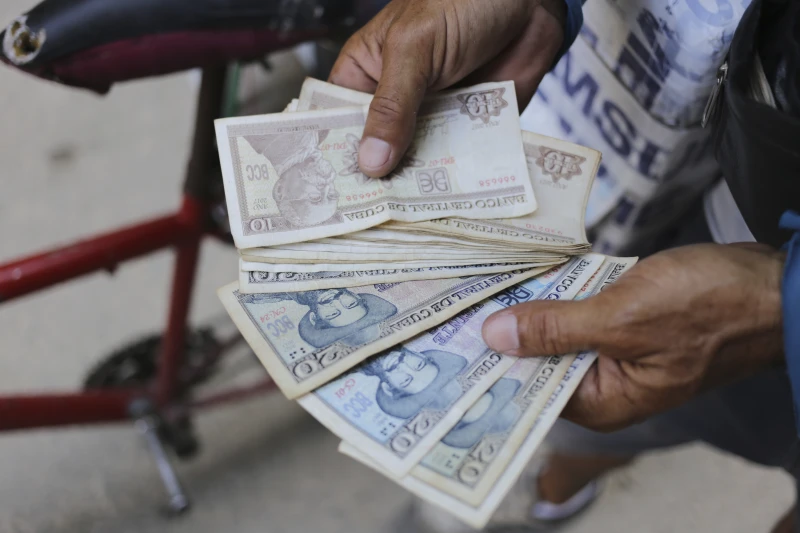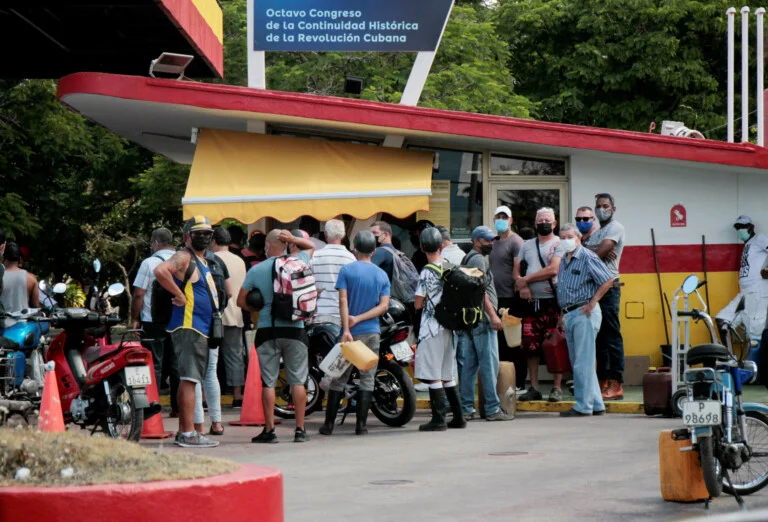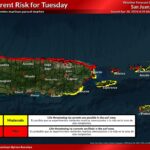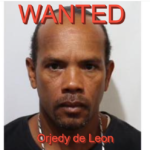HAVANA (AP) — Alejandro Fonseca stood in line for several hours outside a bank in Havana hoping to withdraw Cuban pesos from an ATM, but when it was almost his turn, the cash ran out.
He angrily hopped on his electric tricycle and traveled several kilometers to another branch where he finally managed to withdraw some money after wasting the entire morning.
“It shouldn’t be so difficult to get the money you earn by working,” the 23-year-old Fonseca told The Associated Press in a recent interview.

An ice cream street vendor shows his Cuban pesos in Havana, Cuba, Monday, April 20, 2024.(AP Photo/Ariel Ley)
Fonseca is one of an increasing number of frustrated Cubans who have to grapple with yet another hurdle while navigating the island’s already complicated monetary system — a shortage of cash.
Long lines outside banks and ATMs in the capital, Havana, and beyond start forming early in the day as people seek cash for routine transactions like buying food and other essentials.
Experts say there are several reasons behind the shortage, all somehow related to Cuba’s deep economic crisis, one of the worst in decades.
Omar Everleny Pérez, a Cuban economist and university professor, says the main culprits are the government’s growing fiscal deficit, the nonexistence of banknotes with a denomination greater than 1,000 Cuban pesos (about $3 in the parallel market), stubbornly high inflation and the nonreturn of cash to banks.
“There is money, yes, but not in the banks,” said Pérez, adding that most of the cash is being held not by salaried workers, but by entrepreneurs and owners of small- and medium-size business who are more likely to collect cash from commercial transactions but are reluctant to return the money to the banks.
This, Pérez says, is either because they don’t trust the local banks or simply because they need the Cuban pesos to convert into foreign currency.
Most entrepreneurs and small business owners in Cuba have to import almost everything they sell or pay in foreign currency for the supplies needed to run their businesses. As a consequence, many end up hoarding Cuban pesos to later change into foreign currency on the informal market.
Converting those Cuban pesos to other currencies poses yet another challenge, as there are several, highly fluctuating exchange rates in the island.
For example, the official rate used by government industries and agencies is 24 pesos to the U.S. dollar, while for individuals, the rate is 120 pesos to the dollar. However, the dollar can fetch up to 350 Cuban pesos on the informal market.
Pérez notes that in 2018, 50% of the cash in circulation was in the hands of the Cuban population and the other half in banks on the Caribbean island. But in 2022, the latest year for which information is available, 70% of cash was in the wallets of individuals.
Cuban monetary authorities did not immediately respond to the AP’s emailed request for comment.
The shortage of cash comes as Cubans grapple with a complex monetary system in which several currencies circulate, including a virtual currency, MLC, which was created in 2019.
Then, in 2023 the government announced several measures aimed at promoting a “cashless society,” making the use of credit cards mandatory to pay for some transactions — including purchases of food, fuel and other basic goods — but many businesses simply refuse to accept them.
Making things worse is stubbornly high inflation, meaning more and more physical bills are needed to buy products.
According to official figures, inflation stood at 77% in 2021, then dropped to 31% in 2023. But for the average Cuban, the official figures barely reflect the reality of their lives, since market inflation can reach up to three digits on the informal market. For example, a carton of eggs, which sold for 300 Cuban pesos in 2019, these days sells for about 3,100 pesos.
The monthly salary for Cuban state workers ranges between 5,000 and 7,000 Cuban pesos (between $14 and $20 in the parallel market).
“To live in an economy that, in addition to having several currencies, has several exchange rates and a three-digit inflation is quite complicated,” said Pavel Vidal, a Cuba expert and professor at Colombia’s Javeriana University of Cali.
By ANDREA RODRÍGUEZ/Associated Press
Andrea Rodríguez on X: www.twitter.com/ARodriguezAP



